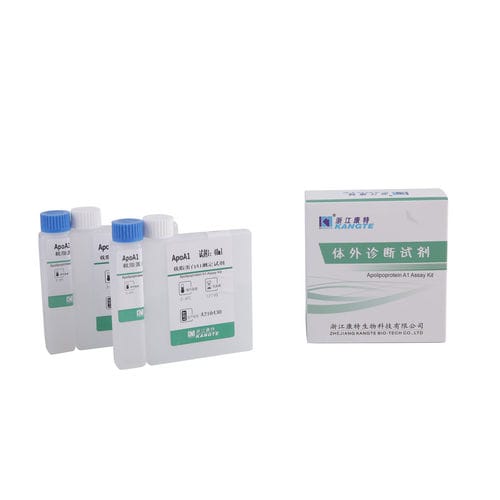
- Laboratory
- Laboratory medicine
- Diabete test kit
- Zhejiang Kangte Biotechnology Co., Ltd.

- Products
- Catalogs
- News & Trends
- Exhibitions
Apolipoprotein assay kit B003 seriesfor liver diseasefor kidney diseasefor cardiovascular diseases
Add to favorites
Compare this product
Characteristics
- Applications
- for liver disease, for kidney disease, for cardiovascular diseases, for diabetes
- Tested parameter
- for apolipoproteins
- Sample type
- serum, clinical
- Analysis mode
- immunoturbidimetric
Description
This kit is used to quantitatively detect the content of apolipoprotein A1 (ApoA1) in human serum in vitro.
Background of Clinical Indications
It is used for the auxiliary diagnosis of coronary heart disease and cerebrovascular disease. ApoA1 is an anti-atherosclerosis indicator. Its decrease can be seen in patients with nephrotic syndrome, active hepatitis, liver parenchymal damage, and diabetes, etc. ApoA1 (together with ApoA2) accounts for 80% to 90% of HDL protein. Therefore, ApoA1 in serum can represent the level of HDL, which is obviously positively correlated with HDL-C. ApoA1 is low in patients with coronary heart disease and cerebrovascular disease, and ApoA1 is extremely low in serum of patients with ApoA1 deficiency, clustered hypo-α lipoproteinemia, and fisheye disease. HDL-C is often low in patients with cluster hypertriglyceridemia, but ApoA1 is not necessarily low, which does not increase the risk of coronary heart disease.
Other Zhejiang Kangte Biotechnology Co., Ltd. products
Blood Lipid
Related Searches
- Assay kit
- Blood assay kit
- Serum assay kit
- Immunoassay assay kit
- Plasma assay kit
- Infectious disease detection kit
- Whole blood detection kit
- Respiratory infection test kit
- Clinical assay kit
- Optical assay kit
- Oncology test kit
- Cell assay kit
- Urine assay kit
- Tissue detection kit
- Antibody assay kit
- Cardiovascular disease assay kit
- Biochemistry assay kit
- Enzyme immunoassay assay kit
- Obstetrical/gynecological test kit
- Endocrine disease assay kit
*Prices are pre-tax. They exclude delivery charges and customs duties and do not include additional charges for installation or activation options. Prices are indicative only and may vary by country, with changes to the cost of raw materials and exchange rates.




